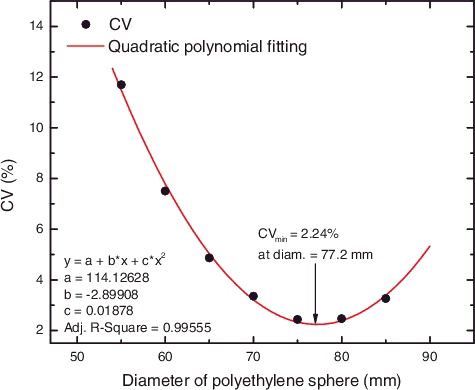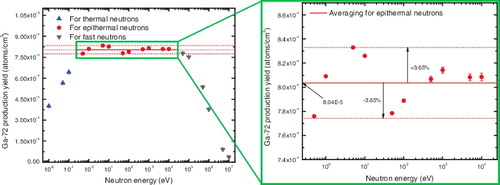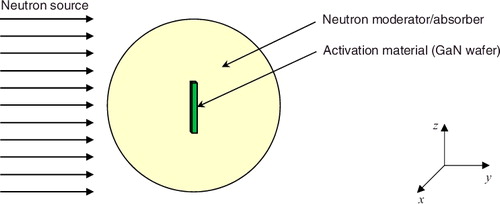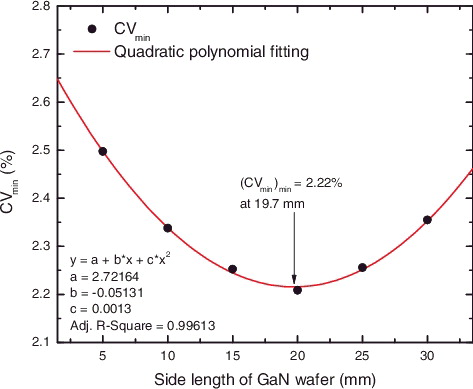 ?Mathematical formulae have been encoded as MathML and are displayed in this HTML version using MathJax in order to improve their display. Uncheck the box to turn MathJax off. This feature requires Javascript. Click on a formula to zoom.
?Mathematical formulae have been encoded as MathML and are displayed in this HTML version using MathJax in order to improve their display. Uncheck the box to turn MathJax off. This feature requires Javascript. Click on a formula to zoom.ABSTRACT
An epithermal neutron (0.5 eV < En < 10 keV) flux monitor developed for boron neutron capture therapy (BNCT) was optimized by Monte Carlo simulations. Based on this optimization study, the optimization results for each component of the epithermal neutron flux monitor were obtained. The simulation results indicated that the epithermal neutron flux monitor with optimal configuration was more efficiently applicable to precisely measure the epithermal neutron fluxes of BNCT neutron sources.
1. Introduction
Boron neutron capture therapy (BNCT) is a very promising cancer radiotherapy technology. Neutron source is one of the key factors for the success of BNCT. At present, epithermal neutron (0.5 eV < En < 10 keV) flux has been one of the basic characteristics for BNCT neutron sources. Thus, to precisely measure the epithermal neutron fluxes of BNCT neutron sources, a simple spherical monitor was developed in the previous work [Citation1,Citation2].
The principle of the developed epithermal neutron flux monitor was based on the activation method using 71Ga(n,γ)72Ga reaction since the monitor sensitivities in epithermal neutron energy range were much more uniform than those of other considered reactions, i.e. 197Au(n,γ)198Au, 151Eu(n,γ)152mEu, 127I(n,γ)128I, 115In(n,γ)116mIn, 55Mn(n,γ)56Mn, 37Cl(n,γ)38Cl and 23Na(n,γ)24Na. Gallium nitride (GaN) wafer was finally selected as the activation material instead of Ga metal because of its high melting point, availability and very few activated products resulted from its nitrogen (N) content. In the monitor, GaN wafer was positioned in the geometrical center of a polyethylene sphere as neutron moderator covered with cadmium (Cd) layer (thermal neutron absorber) outside to give a flat monitor sensitivity curve in epithermal neutron energy range [Citation1]. Experimentally, the epithermal neutron fluxes of BNCT neutron sources can be deduced from the measurement of the main gamma-rays emitted via the decay of 72Ga with a high-purity germanium detector [Citation2].
In this work, the developed epithermal neutron flux monitor was optimized by Monte Carlo simulations using MCNP5 [Citation3] to carry out the optimization calculations. Based on these simulations, the optimization results for each component of the monitor were obtained finally.
2. Materials and methods
2.1. Monte Carlo simulations
In this work, a general Monte Carlo transport code, MCNP5 [Citation3], was used to carry out the monitor optimization calculations. The calculation model is shown in . In the simulations, mono-energetic broad parallel neutron beams were used as neutron sources to obtain the monitor sensitivities (in the form of 72Ga production yields, i.e. the number of 72Ga atoms/cm3 produced from 71Ga(n,γ)72Ga reaction) in epithermal neutron energy range, in which each energy decade was divided into two bins. Track length neutron tally was used to estimate the average neutron flux in each cell of the epithermal neutron flux monitor and JENDL-4.0 [Citation4] was selected as the cross section library to calculate the activation reaction rates. The number of source histories was 5.0 × 108.
2.2. Coefficient of variation
To compare the flatness of the monitor sensitivity curves in epithermal neutron energy range under different monitor configurations, the coefficient of variation (CV) was employed to determine the fluctuation extent of the monitor sensitivities. The CV, which is often expressed as a percentage, is defined as the ratio of the population standard deviation σ to the population mean μ [Citation5], i.e.
(1)
(1)
Generally, the population standard deviation σ and the population mean μ can be estimated using the sample standard deviation S and the sample mean in statistics, thus EquationEquation (1)
(1)
(1) can be transformed into
(2)
(2) where
and
(n is the sample size and xi is the observed value).
Specifically, for calculating the CV of the monitor sensitivities in epithermal neutron energy range, S and can be expressed as
and
, where Yi is the calculated monitor sensitivities (in the form of 72Ga production yields) and 10 is the number of the calculated monitor sensitivities in epithermal neutron energy range,
is the mean value of the 72Ga production yields caused by epithermal neutrons.
The CV indicates the fluctuation extent of the observed values in relation to the mean. Therefore, the fluctuation of the monitor sensitivities in epithermal neutron energy range is smaller for the smaller CV, that is, the monitor sensitivity curve is flatter for the smaller CV.
2.3. Optimization of the GaN wafer thickness
To optimize the thickness of the GaN wafer in the epithermal neutron flux monitor, a series of calculations were carried out using MCNP5 by varying the thickness of the GaN wafer. For each thickness of the GaN wafer, i.e. 0.05, 0.06, 0.075, 0.09, 0.1, 0.11 and 0.125 mm, the monitor sensitivities in epithermal neutron energy range were calculated by varying the diameter of the polyethylene sphere in the monitor. In these optimization calculations, the dimensions of the GaN wafer were fixed at 10 mm × 10 mm and there was no Cd layer covering the monitor since it was employed to reduce the contribution of thermal neutrons incident to the monitor [Citation1].
For each thickness of the GaN wafer, the CV results of the monitor sensitivities in epithermal neutron energy range were calculated by EquationEquation (2)(2)
(2) for different diameters of the polyethylene sphere, i.e. 55, 60, 65, 70, 75, 80 and 85 mm. It indicated that the calculated CV results as a function of polyethylene sphere diameter were well fitted using a quadratic polynomial and there was a minimum CV (CVmin) at a certain polyethylene sphere diameter for each thickness of the GaN wafer [Citation6], owing to the moderation and absorption of the polyethylene sphere for the incident neutrons.
2.4. Optimization of the GaN wafer dimensions
The dimensions (side lengths) of the GaN wafer in the epithermal neutron flux monitor were optimized using MCNP5. The monitor sensitivities in epithermal neutron energy range for different dimensions of the GaN wafer, whose side lengths are 5, 10, 15, 20, 25 and 30 mm, were calculated by varying the diameter of the polyethylene sphere in the monitor. In these optimization calculations, the thickness of the GaN wafer was fixed at 0.088 mm (see Section 3.1 in detail) and there was no Cd layer covering the monitor.
The CV results of the monitor sensitivities in epithermal neutron energy range calculated by EquationEquation (2)(2)
(2) for different diameters of the polyethylene sphere (55, 60, 65, 70, 75, 80 and 85 mm) were well fitted using a quadratic polynomial and a minimum CV (CVmin) at a certain polyethylene sphere diameter was obtained for each side length of the GaN wafer.
2.5. Optimization of the Cd layer thickness
To confirm the proper thickness of the Cd layer covering the epithermal neutron flux monitor, the monitor sensitivities in epithermal neutron energy range for different thicknesses of the Cd layer, i.e. 0, 0.025, 0.05, 0.075 and 0.1 mm, were calculated by varying the diameter of the polyethylene sphere in the monitor using MCNP5. In these calculations, the dimensions and thickness of the GaN wafer were fixed at 19.7 mm × 19.7 mm and 0.088 mm, respectively (see Sections 3.1 and 3.2 for details).
The CV results of the monitor sensitivities in epithermal neutron energy range calculated by EquationEquation (2)(2)
(2) for different diameters of the polyethylene sphere (55, 60, 65, 70, 75 and 80 mm) were well fitted by a quadratic polynomial and a minimum CV (CVmin) at a certain polyethylene sphere diameter was obtained for each thickness of the Cd layer.
2.6. Optimization of the polyethylene sphere diameter
To confirm the appropriate diameter of the polyethylene sphere in the epithermal neutron flux monitor, the monitor sensitivities in epithermal neutron energy range for the GaN wafer with dimensions of 19.7 mm × 19.7 mm and 0.088 mm in thickness (see Sections 3.1 and 3.2 for details) were calculated for different diameters of the polyethylene sphere (55, 60, 65, 70, 75, 80 and 85 mm) in the monitor using MCNP5. There was no Cd layer covering the monitor in these calculations (see Section 3.3 in detail).
3. Results and discussion
3.1. Optimization results of the GaN wafer thickness
Based on the calculation conditions and definitions described in Section 2.3, the CVmin results for different GaN wafer thicknesses were obtained (as shown in ) and a quadratic polynomial was employed to fit the results. As shown in , the CVmin results for different GaN wafer thicknesses were well fitted by a quadratic polynomial and the minimum CVmin, i.e. (CVmin)min, was 2.31% at 0.088 mm thick GaN wafer. Thus, it can be concluded that the optimal thickness of the GaN wafer was 0.088 mm.
Additionally, it was found from that the variation range of the CVmin was very small, i.e. 2.31%–2.34%, when the GaN wafer thickness changed from 0.075 to 0.1 mm. So, it was concluded that the suitable thickness of the GaN wafer in the epithermal neutron flux monitor was 0.075–0.1 mm in practical applications.
3.2. Optimization results of the GaN wafer dimensions
Based on the calculation conditions and definitions described in Section 2.4, the CVmin results for different side lengths of the GaN wafer were obtained (as shown in ) and the results were fitted using a quadratic polynomial. It was found from that the CVmin results for different side lengths of the GaN wafer were well fitted by a quadratic polynomial and the minimum CVmin ((CVmin)min) was 2.22% when the side length of the GaN wafer was 19.7 mm. Thus, it can be concluded that the optimal dimensions of the GaN wafer were 19.7 mm × 19.7 mm.
Additionally, as shown in , the variation range of the CVmin was very small, that is, 2.22%–2.25%, when the side length of the GaN wafer changed from 14.5 to 25 mm. So it was concluded that the appropriate side length of the GaN wafer in the epithermal neutron flux monitor was 14.5–25 mm in practical applications.
3.3. Optimization results of the Cd layer thickness
Based on the calculation conditions and definitions described in Section 2.5, the CVmin results for different Cd layer thicknesses were obtained (as shown in ) and the results were fitted employing a linear polynomial. As shown in , the CVmin had linear increase with the Cd layer thickness, which suggested that the monitor sensitivity curve in epithermal neutron energy range was flatter for the thinner Cd layer.
Practically, since the main components of typical BNCT treatment beams are epithermal neutrons and the thermal neutrons have been almost completely removed especially from the beams that are produced from the accelerator-based neutron source (ABNS) facilities, in which the ratios of epithermal neutron fluxes to thermal neutron fluxes are larger than 100 [Citation7–13]. This indicated that the influence of thermal neutrons on the measurements of the epithermal neutron fluxes is negligible even though there is no Cd layer covering the monitor. So it was concluded that no Cd layer covering the epithermal neutron flux monitor was feasible in practical application especially to measure the epithermal neutron fluxes of ABNSs, which are of great interest to the BNCT neutron source researchers at present since they have feasibility to realize in-hospital BNCT treatment facilities in near future [Citation14,Citation15].
Certainly, when measuring the epithermal neutron fluxes of BNCT neutron sources in which the thermal neutron contaminations are too large to be ignored, the Cd layer needs to be employed to cover the epithermal neutron flux monitor to reduce the contribution of thermal neutrons incident to the monitor. Therefore, based on the CVmin results shown in and the Cd layer thickness reported in the previous work, i.e. 0.05 mm [Citation1], it was concluded that the proper thickness of the Cd layer covering the epithermal neutron flux monitor was 0–0.05 mm in practical applications.
3.4. Optimization results of the polyethylene sphere diameter
Based on the calculation conditions and definitions described in Section 2.6, the CV results of the monitor sensitivities in epithermal neutron energy range calculated by EquationEquation (2)(2)
(2) for different diameters of the polyethylene sphere in the monitor are shown in . It showed that the calculated CV results as a function of polyethylene sphere diameter were well fitted using a quadratic polynomial and the minimum CV (CVmin) was 2.24% when the polyethylene sphere diameter was 77.2 mm. Deservedly, it was the optimal diameter of the polyethylene sphere in the epithermal neutron flux monitor.
Figure 5. CV results of the monitor sensitivities in epithermal neutron energy range for different diameters of the polyethylene sphere.

Additionally, as shown in , the variation range of the CV was very small, i.e. 2.24%–2.27%, when the polyethylene sphere diameter changed from 76 to 78 mm. So it was concluded that the acceptable diameter of the polyethylene sphere in the epithermal neutron flux monitor was 76–78 mm in practical applications.
3.5. The optimization results of the monitor
The optimization results for each component of the epithermal neutron flux monitor obtained in Sections 3.1–3.4 are summarized in . The sensitivities of the epithermal neutron flux monitor with optimal configuration in the neutron energy range from 0.01 eV to 10 MeV were calculated by MCNP5 and the results are shown in .
Table 1. Optimization results for each component of the epithermal neutron flux monitor.
Figure 6. The sensitivities of the epithermal neutron flux monitor with optimal configuration in the neutron energy range from 0.01 eV to 10 MeV. The fluctuation of the monitor sensitivities in epithermal neutron energy range was within ±3.65% relative to the average value.

As shown in , the fluctuation of the monitor sensitivities in epithermal neutron energy range was very small, i.e. within ±3.65%, relative to the average value, which was smaller than that for the monitor designed in the previous work [Citation1], that is, within ±4.6%. This meant that the sensitivity curve in epithermal neutron energy range for the monitor with optimal configuration was flatter than that for the previously designed monitor [Citation1]. Therefore, it was concluded that the epithermal neutron fluxes of BNCT neutron sources can be more precisely measured by the optimized monitor.
4. Conclusions
In this work, to optimize the epithermal neutron flux monitor developed for BNCT, a lot of Monte Carlo simulations were carried out using MCNP5. Based on the optimization calculations, the optimization results for the components of the epithermal neutron flux monitor were obtained. The sensitivities of the epithermal neutron flux monitor with optimal configuration in the neutron energy range from 0.01 eV to 10 MeV were calculated by MCNP5. It was concluded from the results that the epithermal neutron fluxes of BNCT treatment beams can be more precisely measured by the optimized monitor, that is, the optimized epithermal neutron flux monitor will be more efficiently applicable to evaluate the epithermal neutron fields for practical BNCT neutron sources.
Acknowledgments
This work is supported by the Fundamental Research Funds for the Central Universities of China [lzujbky-2017-15] and Mitsubishi Heavy Industries Mechatronics Systems, Ltd. One of the authors, Xingcai Guan, is very grateful to the China Scholarship Council for the financial support.
Disclosure statement
No potential conflict of interest was reported by the authors.
Additional information
Funding
References
- Guan XC, Manabe M, Murata I, et al. Design of an epi-thermal neutron flux intensity monitor with GaN wafer for boron neutron capture therapy. J Nucl Sci Technol. 2015;52(4):503–508.
- Guan XC, Manabe M, Tamaki S, et al. Experimental study on the performance of an epithermal neutron flux monitor for BNCT. Appl Radiat Isot. 2016;113:28–32.
- X-5 Monte Carlo Team. MCNP – a general Monte Carlo n-particle transport code, Version 5 (LA-UR-03-1987). Los Alamos (NM): Los Alamos National Laboratory; 2003.
- Shibata K, Iwamoto O, Nakagawa T, et al. JENDL-4.0: a new library for nuclear science and engineering. J Nucl Sci Technol. 2011;48(1):1–30.
- Everitt BS. The Cambridge dictionary of statistics. New York (NY): Cambridge University Press; 1998.
- Guan XC. [Theoretical design and experimental studies of neutron flux monitors from 0.5 eV to several hundred keV] [Ph.D. thesis]. Lanzhou: Lanzhou University; 2016. Chinese.
- Fantidis JG, Saitioti E, Bandekas DV, et al. Optimised BNCT facility based on a compact D-D neutron generator. Int J Radiat Res. 2013;11(4):207–214.
- Fantidis JG, Antoniadis A. Optimization study for BNCT facility based on a DT neutron generator. Int J Radiat Res. 2015;13(1):13–24.
- Hang S, Tang XB, Shu DY, et al. Monte Carlo study of the beam shaping assembly optimization for providing high epithermal neutron flux for BNCT based on D-T neutron generator. J Radioanal Nucl Chem. 2016;310:1289–1298.
- Bisceglie E, Colangelo P, Colonna N, et al. Production of epithermal neutron beams for BNCT. Nucl Instrum Meth A. 2002;476(1–2):123–126.
- Burlon AA, Kreiner AJ. A comparison between a TESQ accelerator and a reactor as a neutron sources for BNCT. Nucl Instrum Meth B. 2008;266(5):763–771.
- Tamaki S, Sakai M, Yoshihashi S, et al. Mock-up experiment at Birmingham University for BNCT project of Osaka University – neutron flux measurement with gold foil. Appl Radiat Isot. 2015;106:72–74.
- Inoue R, Hiraga F, Kiyanagi Y. Optimum design of a moderator system based on dose calculation for an accelerator driven boron neutron capture therapy. Appl Radiat Isot. 2014;88:225–228.
- Guan XC, Murata I, Wang TS. Design study of neutron flux intensity monitor between ten and several hundred keV for BNCT. J Nucl Sci Technol. 2016;53(8):1112–1119.
- Guan XC, Manabe M, Tamaki S, et al. Performance testing of the neutron flux monitors from 10 keV to 1 MeV developed for BNCT: a preliminary study. Appl Radiat Isot. 2017;125:119–123.




